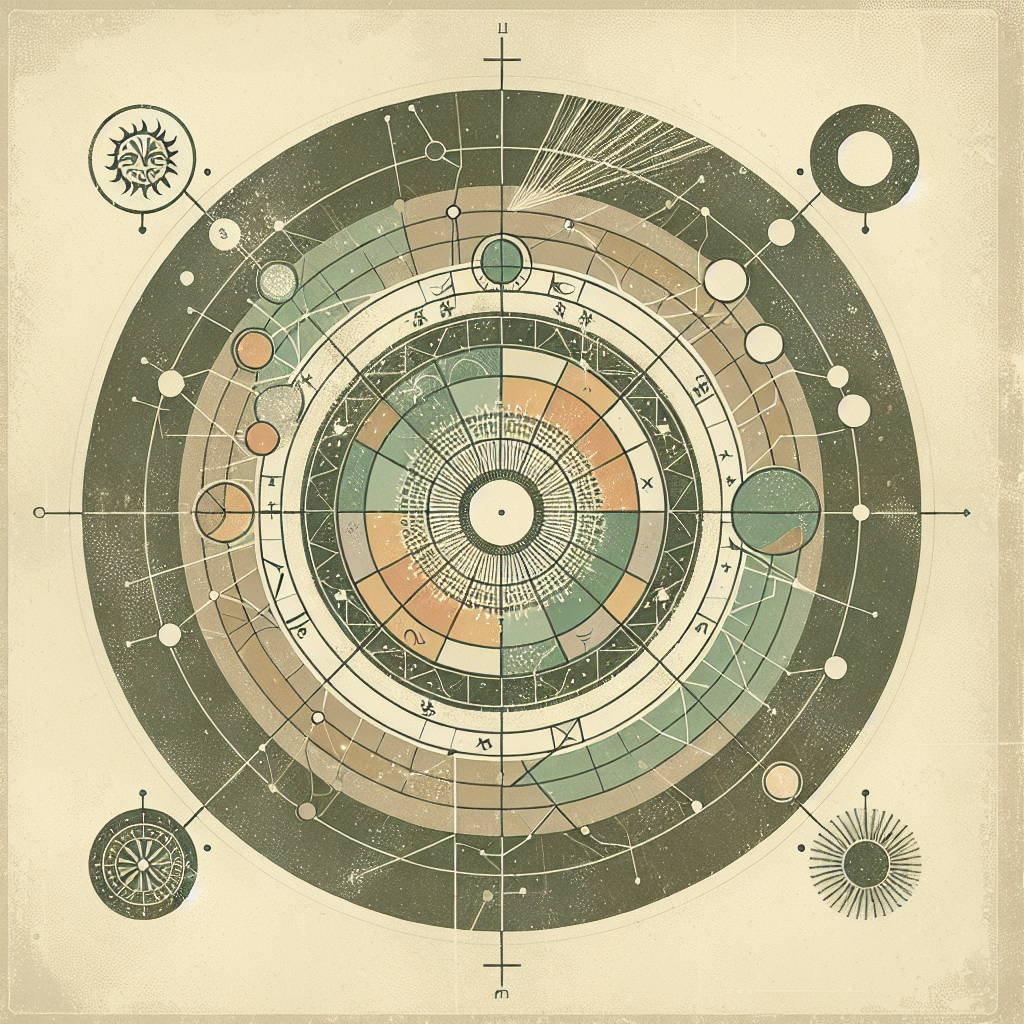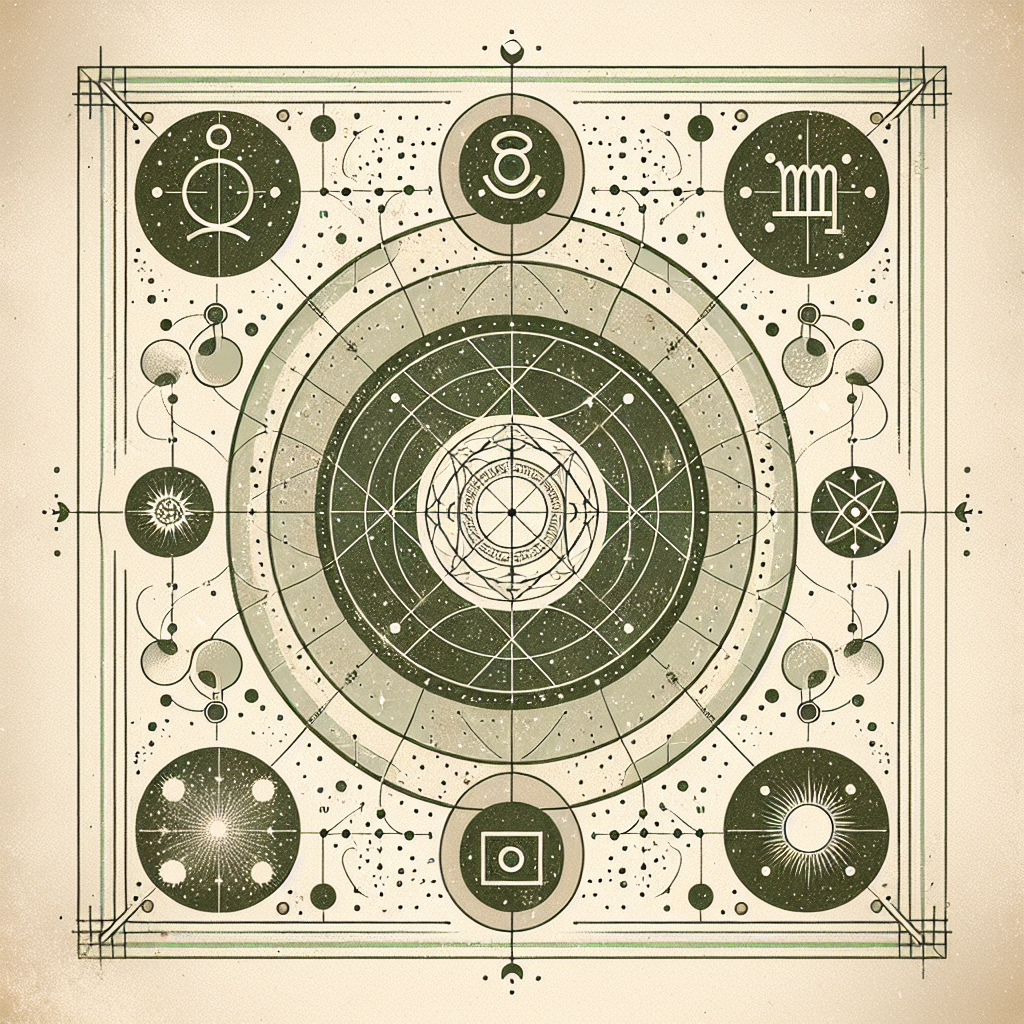
Introduction
Astrology (Greek: astrologia, ἀστρολογία; Latin: astrologia; Arabic: ‘ilm al-nujūm, علم النجوم; judicial astrology often termed ahkām al-nujūm, أحكام النجوم) is the practice of interpreting celestial phenomena—planets, luminaries, and stars—in relation to earthly events and human lives. In historical usage across the ancient Mediterranean and Near East, the term overlapped with astronomy; only gradually did observational astronomy and interpretive astrology become distinct pursuits. In many premodern settings, astrology was embedded in scholarship, medicine, politics, and elite court culture. Today it persists in popular and specialist forms, while its causal claims remain contested by modern science. [2][3][4]
While the field asks empirical questions, it also tracks how people have sought patterns of connection in a sky full of mystery, using the heavens as a meaningful guide to life’s tides.
How It Started & Developed
The earliest foundations of what becomes “astrology” lie in Mesopotamian divination. From the second millennium BCE, scholars compiled large omen series correlating celestial phenomena and terrestrial outcomes, notably the extensive compendium often called Enūma Anu Enlil. These texts framed the heavens as a meaningful sign‑system. By the late first millennium BCE, Mesopotamian practitioners developed mathematical astronomy and a standardized zodiac, enabling more systematic forecasts. Crucially, by the fifth to fourth centuries BCE, scribes in the Babylonian cultural sphere produced the earliest surviving individual natal horoscopes, indicating a shift from state-level omens to personalized celestial judgments. [1]
In Hellenistic Egypt (especially Alexandria, second–first centuries BCE), Babylonian astral sciences merged with Greek philosophical physics, medicine, and geometry. The result was “horoscopic astrology,” which uses the positions of the Sun, Moon, and planets relative to a twelve‑sign zodiac and horizon-based “places” (topoi) at the moment of birth. The system incorporated elemental and humoral theories, the doctrine of aspects (configured angles between planets), and a more unified technical vocabulary. The most influential synthesis is Claudius Ptolemy’s Tetrabiblos (second century CE), which framed astrology as a natural, probabilistic science subordinate to astronomy and embedded its rationales in Aristotelian cosmology and humoral medicine. Ptolemy advocated the tropical zodiac, anchoring the signs to the equinoxes and solstices rather than fixed stars—a decision that decisively shaped later Western practice. [2] See Ptolemy’s core exposition in the Tetrabiblos.
Astrology entered Late Antique and early Byzantine culture through Greek handbooks and commentaries. From the ninth century, Arabic-speaking scholars, working in Baghdad and other centers, translated and expanded Greek materials (including Ptolemy), systematizing techniques and composing influential treatises. In this milieu, figures such as Abū Ma‘shar (Albumasar) helped to transmit and transform doctrines that would later be rendered into Latin. The twelfth-century translation movement in Iberia and Italy funneled these texts into Latin Christendom, where astrology was debated theologically but also taught at universities alongside astronomy and medicine. Medical astrology (iatromathematics) and political or “mundane” astrology flourished; astrologers cast nativities, advised rulers, and produced almanacs. [3]
The Renaissance saw both sophisticated practice and robust critique. Astrology’s naturalistic defenses (e.g., planetary “qualities” acting on the sublunary world) were refined, but skepticism intensified. Giovanni Pico della Mirandola’s Disputationes adversus astrologiam divinatricem (published 1496) argued that astrological techniques lacked logical and empirical warrant, influencing later humanists and theologians. The scientific revolution further eroded astrology’s academic standing as mechanical philosophy and observational astronomy decoupled celestial motions from astrological causation. Nonetheless, astrology remained active in vernacular print, almanacs, and certain courtly milieus into the seventeenth century. [3]
A modern popular revival gathered momentum from the late nineteenth century. Occult and theosophical currents reframed astrology as symbolic psychology and spiritual cosmology; British astrologer Alan Leo (1860–1917) standardized popular manuals and emphasized character analysis over deterministic prediction. In the early twentieth century, newspaper horoscope or “sun‑sign” columns translated complex nativities into birth‑sign summaries, reaching mass audiences. After mid‑century, depth‑psychological approaches influenced by C. G. Jung encouraged interpretive models linking planetary symbolism to archetypal patterns. By century’s end, astrology was simultaneously a popular entertainment, a counseling‑oriented practice, and a subject of continuing debate among historians, sociologists, and skeptics. [3][4]
Main Beliefs & Practices
Although techniques vary, several shared premises characterize Western horoscopic astrology:
-
Macrocosm and microcosm. Celestial configurations correspond to patterns in the sublunary world, including individual temperament and collective events. Hellenistic authors framed this as a lawful, natural relation rather than mere omen‑reading, while acknowledging probabilistic limits. Ptolemy explicitly treats astrology as less exact than astronomy and stresses that outcomes are modulated by material conditions and human affairs. [2]
-
Zodiac and planets. The zodiac is a twelve‑sign band (Aries through Pisces), each sign carrying elemental and qualitative associations. Western astrology generally uses the tropical zodiac, beginning at the vernal equinox. Planets—including the Sun and Moon as “luminaries”—are assigned benefic or malefic tendencies and humoral “powers” (e.g., Mars as heating/drying, Saturn as cooling/drying), derived from ancient physics and medical theory. [2]
-
Aspects and configurations. Angular relationships between planets—such as conjunction, opposition, trine, square, and sextile—are interpreted via geometrical harmony or tension, reflecting the Pythagorean and Aristotelian geometries underlying ancient cosmology. [2]
-
Houses (places, topoi) and angles. The horoscope is divided by the horizon and meridian into twelve places related to life domains (body, resources, kin, illness, partnership, etc.). The four angles (Ascendant, Descendant, Midheaven, and Imum Coeli) structure the chart and modulate planetary significance. Hellenistic sources vary in technical details, and medieval/early modern astrologers further systematized house meanings. [2][3]
-
Branches of practice. Natal astrology interprets a birth chart to describe character and potentials; electional astrology chooses “propitious” times for actions; horary astrology answers specific questions based on the chart for the query’s moment; mundane astrology considers weather, politics, and collective affairs via eclipses, ingresses, and cyclical indicators. These branches coexisted from antiquity through the early modern period, with periodic shifts in emphasis. [2][3]
-
Medical and melothesia. Classical and medieval systems mapped zodiacal signs and planetary rulerships to the body’s parts and humors (melothesia), guiding bloodletting and treatment timing. This was justified within premodern medical cosmology; modern clinical efficacy for such timing has not been demonstrated. [2][3][4]
Methodologically, Ptolemy’s Tetrabiblos is central to later Western theory: it argues for natural causes (qualities mediated by solar heating, lunar moisture, and planetary cycles), probabilistic judgments, and the need to integrate general celestial indications with particular local circumstances. Many subsequent astrologers accepted Ptolemy’s rationalizations even when they expanded technical repertoires. [2]

Membership & Initiation
Astrology has never been a single centralized institution with uniform doctrines or an initiation rite. Historically it functioned as a learned craft taught through textual study, mathematical training, and apprenticeship. In the Hellenistic and Roman periods, astrologoi and mathematici worked as consultants; in the medieval Latin West and the Islamicate world, astrology was tied to scholarly curricula alongside astronomy and medicine, and court astrologers served princes and cities. With the early modern shift away from university endorsement, practice continued in almanac production, private consultation, and artisan or printerly milieus. [3]
In contemporary settings, astrologers typically learn through self‑study, mentorship, specialized schools, or professional associations; practices range from traditional technique to psychological or spiritual counseling frameworks. There is no universally recognized license or ordination. Claims that astrological counseling has therapeutic efficacy should be interpreted cautiously: while practitioners may draw on counseling methods, robust clinical evidence for astrology as a treatment modality is lacking. [3][4] Readers often encounter a daily or weekly horoscope through media, but professional training remains varied and decentralized.
Its Influence & Modern Forms
Across two millennia, astrology has influenced intellectual history, cultural production, and everyday life in several ways:
-
Knowledge systems. In antiquity and the Middle Ages, astronomy and astrology were interdependent; astronomical tables, eclipse predictions, and planetary models were valued partly because they enabled astrological judgments. Universities treated astrological topics under natural philosophy and medicine; key debates about fate, free will, and contingency used astrological examples to articulate doctrines of divine providence and natural causation. [2][3]
-
Medicine and agriculture. Medical calendars and almanacs advised on bloodletting and regimen using zodiacal and lunar cycles; agricultural almanacs timed sowing and harvesting. Although integral to premodern practice, such timing rules do not have demonstrated efficacy by modern standards. [3][4]
-
Politics and society. Court and civic astrologers advised on coronations, journeys, and warfare; “mundane” prognostications tied eclipses and planetary ingresses to weather, epidemics, and political change. This advisement played into legitimacy and statecraft in varying degrees across polities. [2][3]
-
Literature, art, and symbolism. Zodiacal imagery pervades manuscripts, architecture, and visual arts; literary works from Dante to early modern poetry embed astrological cosmology. The zodiac furnished a shared symbolic language for temperament, virtue, and vice, and a recurring symbol in art and narrative. [3]
-
Popular culture and revival. From the late nineteenth century, esoteric and psychological currents recast astrology as symbolic and character‑analytic. In the twentieth century, newspaper and magazine horoscope columns introduced simplified astrology to mass audiences, while handbooks standardized birth‑chart interpretation for general readers. Late twentieth‑ and early twenty‑first‑century practice diversified into traditionalist revivals, archetypal/psychological approaches, and digital platforms offering charting and daily forecasts. [3]
-
Appraisal and evidence. Rigorous experimental tests of natal astrology’s central claims—such as whether astrologers can match birth charts to validated personality profiles better than chance—have generally not supported astrological efficacy. A widely cited double‑blind test published in Nature (1985) reported that participating astrologers were unable to identify the correct personality profiles above chance levels despite agreeing to the protocol in advance. Subsequent scholarly and practitioner debates have critiqued methodologies or offered reanalyses, but there is no broad body of robust, replicable findings establishing astrological predictions as reliable in controlled settings. [4][3]
Terminological distinctions matter when discussing modern practice. Western astrology ordinarily uses the tropical zodiac, defined by the Sun’s apparent motion relative to equinoxes and solstices, whereas some other traditions employ sidereal zodiacs anchored to stellar positions; the former choice follows the Hellenistic and especially Ptolemaic precedent. Within Western practice, technical vocabularies for aspects, house systems, and predictive methods vary across schools (for example, traditional, Renaissance, and psychological schools), but all presume meaningful correspondences between celestial configurations and human affairs. [2][3]
In sum, astrology has a documented, complex history from Mesopotamian omen literature to Hellenistic theoretical synthesis, medieval scholarly canonization, early modern contestation, and modern reinvention. Its intellectual influence on cosmology, medicine, and cultural symbolism is well attested; its central empirical claims have not been verified to scientific standards. Present‑day astrology thus functions chiefly as a symbolic or meaning‑making practice—sometimes integrated with counseling frameworks—rather than a science in the contemporary sense. Along that arc, readers meet living traditions that invite reflection, connection, and practical wisdom without departing from careful historical evidence. [1][2][3][4]
Sources
[1] Francesca Rochberg, The Heavenly Writing: Divination, Horoscopy, and Astronomy in Mesopotamian Culture, 2004. Authoritative study of Mesopotamian astral sciences and the emergence of horoscopy. https://doi.org/10.1017/CBO9780511617409
[2] Claudius Ptolemy, Tetrabiblos, trans. F. E. Robbins, 1940 (primary source). Foundational Hellenistic synthesis articulating theoretical bases and techniques of astrology. https://penelope.uchicago.edu/Thayer/E/Roman/Texts/Ptolemy/Tetrabiblos/
[3] Nicholas Campion, A History of Western Astrology, Volume II: The Medieval and Modern Worlds, 2009. Scholarly survey from medieval institutionalization to modern popular and psychological forms. https://www.bloomsbury.com/us/history-of-western-astrology-volume-ii-9781441181299/
[4] Shawn Carlson, “A double‑blind test of astrology,” Nature 318 (1985): 419–425. Influential controlled study evaluating astrologers’ accuracy against validated personality measures. https://doi.org/10.1038/318419a0